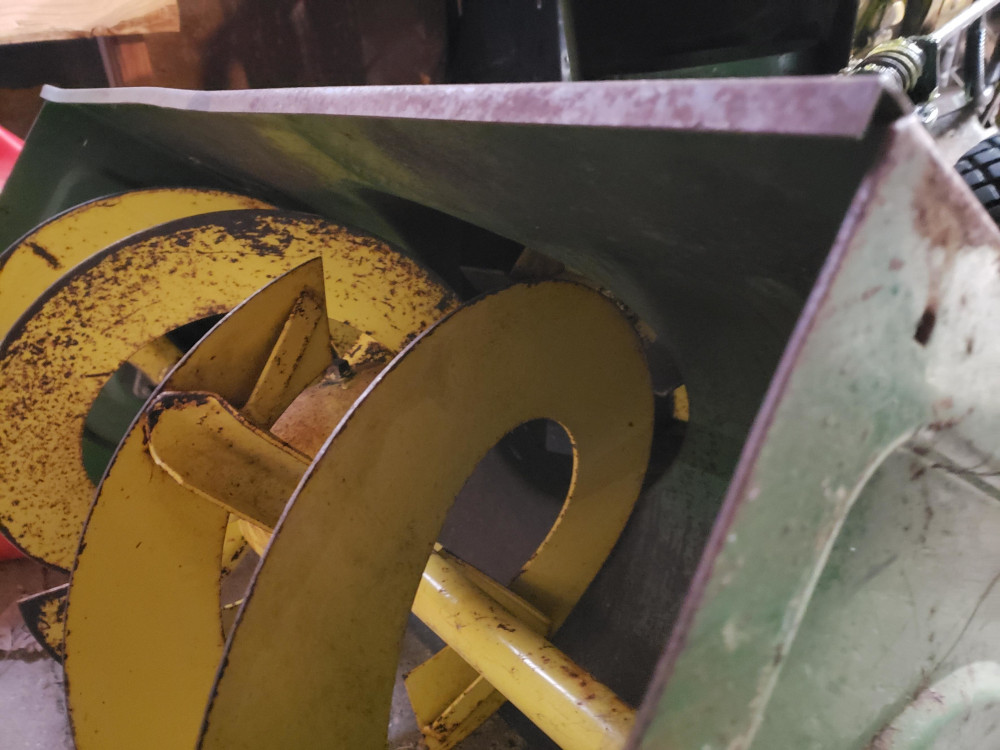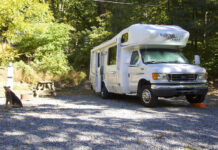
With the winter chill setting, it’s time to break out the snowblower and keep your driveway clear of snow. But before you can get your snowblower working at its best, you need the right lubricant for the chute. Don’t worry – we’ve got you covered! Let’s find the best lube to keep your snowblower chute working like a charm this winter.
Top snow blower chute lubricants
- Non-stick clear coating formulated with Teflon fluoropolymer and silicone to ensure optimum non-stick performance
- Prevents snow and ice buildup, frozen doors and clogged augers and chutes
- Apply to snow blowers, door gaskets and snow shovels
- Also great for snow mobiles, snow plows, and gutters and leaders
- Includes (1) 8 oz bottle of Ariens L3 Lubrication
- Designed to work in all Ariens Snowblowers (aluminum and cast iron gear cases)
- L1 and L2 lubrication now supercede to the L3
- 11 fl. oz. can
- Size: 11
- Formulated specifically for snowblowers
- Non-stick polymer treatment prevents snow buildup in the auger housing and chute areas of the snowblower
- Snow-Jet spray reduces friction and helps blow snow further
- CRC INDUSTRIES: A market leader that offers impeccably designed chemical solutions to maintain, protect and repair different marine, heavy-duty motor vehicles, industrial-grade engines, household tools and electrical equipment
- CHUTE LUBE: This NSF H2 registered silicone spray creates an odorless and colorless, non-staining film to eliminate the binding and sticking of different packages and boxes in package handling equipment.
- RELIABLE PERFORMANCE: Works on wide temperatures, ranging between -40 to 400-degree F. This lubricant provides low surface tension and minimizes corrosion when used on various metal and non-metal contact areas. It effectively reduces friction and galling.
- APPLICATIONS: Recommended to lubricate package handling equipment such as chutes, slides, guides, and rails. Helps packages slide easier and works well even in wet conditions.
- PRODUCT SPECIFICATIONS: CRC Chute Lube comes in a 11 wt oz aerosol can.
- ENHANCE PERFORMANCE - B'laster Silicone Lubricant contains a higher concentration of silicone than competitor brands, which provides longer-lasting lubrication.
- NO STAIN - Its clear, non-evaporating formula eliminates wear from constant friction and is safe and non-staining.
- NO DIRT - Dust and dirt won’t be a problem because B’laster silicone lubricant leaves a no-track film that won’t accumulate dust and dirt.
- PRESERVE - Lubricates and protects elastomers, metal, plastic, wood, rubber, vinyl, and leather.
- Ariens Snow-Jet Non-Stick Polymer Treatment 11 oz.
- 4-Cycle SAE 5W30 Sno-Thro Engine Oil
- For use on all Ariens 4-cycle Sno-Thro Models
- 8oz Synthetic Severe-Duty Gear Lube
- DuPont Silicone Surface Safe Lubricant with Non-Stick Ceramic Technology, reduces friction, prevents parts sticking, and stops squeaks. It is safe for use on all surfaces including non-metal materials that can become damaged by conventional lubricants.
- Silicone's advanced formula is enhanced with Nano-Ceramic Boron Nitride particles to waterproof, protect, lubricate, and preserve rubber, plastic, vinyl, leather, metal, and wood surfaces.
- With an operating temperature ranging from -40°F (-40°C) to 392°F (200°C), it's ideal for home, auto and marine applications. Silicone reduces the build-up of dirt, mud, snow, and ice, even in the most challenging conditions .
- Non-staining, low-odor, and NSF H-2 approved as a food-grade product.
- Perfect for mechanical equipment, hinges, locks, window tracks, fitness equipment, garden tools, and snow blowers.
- Unique 100% dry-film Teflon coating and lubricant
- Clean, long-lasting micro-thin, dirt-resistant coating effective from -100F to +500F
- Uses proprietary resin-bonding technology for tight tolerance, metal-on-metal applications
- Creates a thin, dirt-repelling, chemical-resistant coating
- Safe for all surfaces does not contain silicone
- ENHANCE PERFORMANCE - B'laster Silicone Lubricant contains a higher concentration of silicone than competitor brands, which provides longer-lasting lubrication. Formulated with Teflon Fluoropolymer to enhance performance.
- NO STAIN - Its clear, non-evaporating formula eliminates wear from constant friction and is safe and non-staining.
- NO DIRT - Dust and dirt won’t be a problem because B’laster silicone lubricant leaves a no-track film that won’t accumulate dust and dirt.
- PRESERVE - Lubricates and protects elastomers, metal, plastic, wood, rubber, vinyl, and leather.
Affiliate links / Images from Amazon Product Advertising API
Guide to keeping your snow blower chute lubed
This guide will provide a comprehensive overview of the different types of lubricants available and how they should be used properly to help keep your snowblower chute in top condition.
From synthetic oils to grease and silicone-based products, exploring the options and maintenance tips can help you get the most out of your snowblower chute with minimal effort.
There are several things to consider when selecting the right product for your needs, including temperature, environment, lubrication requirements, and application methods.
We will cover all of these topics in detail below so you can make an educated decision when it comes time to purchase a lube for your snowblower chute.
All products featured in this guide have been tested on various machines and are widely considered to be some of the best lubricants available for snowblower chutes.
Types of Lubes
Using the proper lubricant on your snowblower chute can help prolong the life of the machine, prevent corrosion, and reduce friction. Here are a few common types of lubes you may want to consider:
- Silicone lubricants: While most silicone lubricants are waterproof, many regular formulas will still be effective in between intermittent cleaning and drying sessions. Non-toxic and non-staining varieties may also be ideal depending on your application.
- Teflon Lubricants: Teflon is a great choice for extreme weather applications as it won’t freeze or run off quickly in cold temperatures. It is also chemically inert, so it won’t corrode any surfaces with which it comes into contact.
- White Lithium Grease: Lithium grease has very high performance characteristics regardless of temperature or environment, meaning it’s ideal for cold climates that don’t require frequent maintenance. It’s also fairly resistant to washout from water or other liquids and will not break down over time as easily as petroleum products can.
- Petroleum Jelly: Petroleum jelly can be effective at reducing surface friction but should not be used if you plan to use your snowblower in wet conditions, since water can break down the jelly very quickly.
No matter what lubricant you choose, always make sure it is compatible with the materials of your snowblower parts before applying it to avoid damaging the chute or any other components of the machine.
Benefits of Lubricating a Snowblower Chute

Regular lubrication keeps snowblowers operating efficiently and correctly. Lubricants help protect the metal parts of the snowblower from damage caused by heat, friction, rust, and corrosion.
It also helps maintain the smoothness of the rotation of moving parts by reducing friction between them.
Lubricants are essential for keeping snow blowers working well during cold winter months. Additionally, it helps prevent snow and slush from sticking to the chute which can cause clogs and inefficiencies with throwing or blowing snow when clearing driveways or sidewalks.
When used correctly, lubes like WD-40 or lithium grease improve the life of your machine while simultaneously ensuring maximum efficiency during use.
When it comes to choosing a specific lube for your snowblower chute, different conditions require different options. In general, you should choose a lubricant that is resistant to freezing temperatures and has good durability against weathering elements. Lubricants should also be designed to repel dirt and water making them easy to clean after use. Special spray-on or aerosolized versions are available that make applying lube simple too!
Selecting the Right Lube for Your Snowblower Chute
Choosing the right lube for your snowblower chute is one of the most important maintenance steps you can take for optimal snowblower performance. Without appropriate lubrication, your chute can become corroded and cause your machine to malfunction or even stop working altogether.
Different types of lubes vary in terms of their effectiveness, suitability for different kinds of weather, and application processes. Common types of lubricants used on snowblower chutes include aerosol sprays, oil-based formulas, graphite powder, and chain saw lubricants:
- Aerosol Sprays: These lubricants come in aerosol cans and offer quick, easy application. They are suitable for cold temperatures and recommended especially when you are working with plastic parts such as the snowblower chute handle or deflector guards. Aerosol sprays provide a protective film that helps keep your machine from freezing up during colder times of year.
- Oil-Based Formulas: These lubricants are ideal for cold temperatures but can also be used in warmer conditions if necessary. Oil-based formulas generally provide better protection than aerosols because they penetrate more deeply into components such as gears or pulleys on your snow blower’s auger assembly, which may be subject to significant corrosion due to long periods of exposure to dampness from melting snow. Oil-based products usually come in bottles; you will need to apply them with a cloth or brush if possible, as most hands-on application methods will push away the protective coating that forms when the oil evaporates quickly.
- Graphite Powder: This type of lube is widely available and often used by professionals on outdoor machinery components like gearboxes or chainsaw blades due to its superior water-repelling qualities. When applied correctly with a cloth or brush, graphite powder adheres well to metal surfaces and prevents rusting even over extended periods of accumulation in wet conditions. Dust particles generated by this type of powder may be airborne; so it’s important to use it only in well-ventilated areas such as outdoors while wearing respirators that filter out the fine dust particles created by rubbing the graphite onto metal surfaces.
- Chain Saw Lubricant: Chain saw lubricant offers superior protection against corrosion due to its tacky composition; it seals aggressively against dirt and water particles that infiltrate through tiny openings present on any outdoor machinery component over time due to regular wear and tear caused by normal operation cycles (elevated temperature changes). This type of product is specially designed for high contact areas like conveyor belts or augers; it forms a densely packed layer once applied which prevents excessive moisture from coming into contact with any component where such fluid might cause corrosion damage upon contact overtime – making it an invaluable tool when maintaining things like Snow Blowers during winter months when large accumulations occur regularly outdoors due to cold weathers stretching into springtime months throughout temperate climates around USA & Canada regions all across North America (reference).
How to Apply the Lube
Applying the proper lubricant to your snowblower chute will help extend the life of your machine. The type of lube required depends on the material from which your chute is made. Generally, you should use a silicone-based lubricant for plastic chutes, and a graphite-based lube for metallic chutes.
When applying lube to a plastic chute, start by applying a thin coating of silicone spray or oil that is labeled safe for plastic surfaces. Keep in mind that some aerosol sprays may contain ingredients that are corrosive to metals, so you’ll want to avoid these if your snowblower contains both metal and plastic parts. Once you’ve liberally applied the lube to the chute surfaces, wipe off any excess with a rag or paper towel.
If you’re dealing with a metal snowblower chute, a light application of graphite-based lubricant should be enough to prevent sticking and rusting. Apply liberally with an applicator brush and remember to cover all surface areas fully before wiping off any excess lube with a clean cloth.
Once you have finished applying the lube, be sure to double check all parts of your snowblower for any signs of wear or damage caused by age or normal use. If any components need replacing or repair before usage, make sure these tasks are taken care of before running the machine again in order keep it operating at its peak condition for years to come!
Common Mistakes to Avoid
Before lubricating your snowblower’s chute, it’s important to avoid certain common mistakes that can cause more harm than good. Here are some things to keep in mind:
- Using the wrong type of lubricant. You should never use grease or anything that contains petroleum-based ingredients on a snowblower chute. The best type of lube is one specifically designed for snowblowers.
- Applying too much or too little lubricant. It’s important to find the right balance between not enough and too much lube when applying it to the chute of your snowblower. Too much will attract dirt and cause clogging; too little won’t provide sufficient protection from wear and tear.
- Not checking other components for wear and tear. In addition to lubricating, you should always check for worn parts and replace them if necessary as part of your regular maintenance routine. Be sure to inspect items like belts, wheels, linkages, brushes, discharge tube protectors, etc., in addition to the chute itself before lubricating it with the appropriate product(s).
- Not adequately cleaning the area first. It’s important to make sure you clean off any dirt or debris from areas near where you will be applying the lube before beginning any work so as not to contaminate it afterwards with airborne particles once you begin operating your machine again.
Frequently Asked Questions
It is important to choose the right lubricant for maintaining and operating your snowblower. Different machines may require different types of lubricants, so it’s best to consult with the manufacturer when selecting a product. Here are some commonly asked questions about lubricating a snowblower chute.
- What Type of Lube Is Right for A Snowblower Chute? The type of lubricant that should be used on the chute depends on the material it is made of. Most often, metal chutes will require multi-purpose SAE 30 non-detergent oil while plastic chutes need special plastic-safe lubes such as slick 50 or WD-40 Specialist Snow Thrower Lubricant.
- How Often Should I Lubricate My Snowblower Chute? Most manufacturers recommend that you lubricate your snow blower every few weeks in order to maintain optimal performance and reduce friction between moving parts. You may also rub silicone spray onto dry areas of the chute for added protection against wear and tear or environmental elements such as water or heat damage.
- Can I Use Grease On My Snowblower Chute? Some manufacturers suggest using grease, but using multipurpose non-detergent oil is usually sufficient and easier to apply than grease. Furthermore, when too much grease is used it can make your machine harder to move due to increased friction between moving parts, so be sure not to overdo it!
Final thoughts about good snow blower chute lubricants
Overall, the best lube for a snowblower chute is a PTFE-based lube, as it is designed specifically to withstand extreme temperatures and will not freeze or evaporate. This type of lube is best applied once the chute has been thoroughly cleaned and dried.
However, all lubricants should be used in moderation as too much can actually create more friction by gumming up the works rather than reducing it. Be sure to use only manufacturer-approved lubricants to ensure optimal performance.
Find the best lube for snowblower chutes on Amazon.
Originally posted 2023-01-23 20:38:12.


